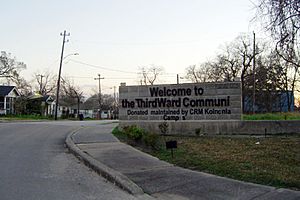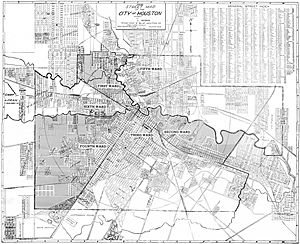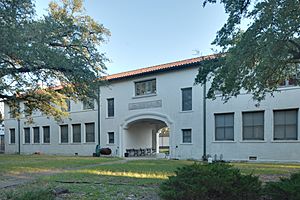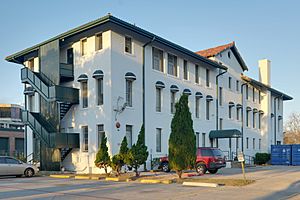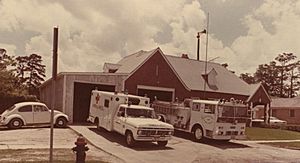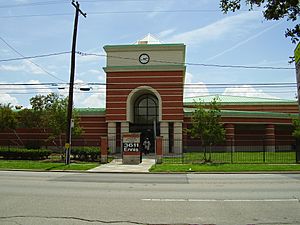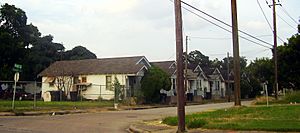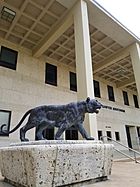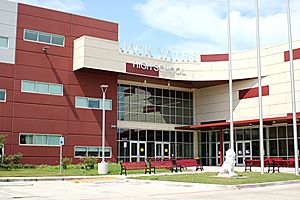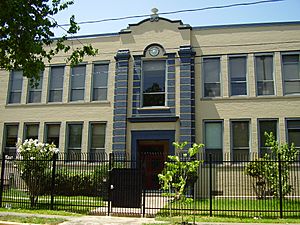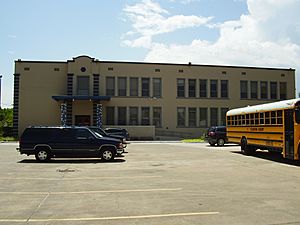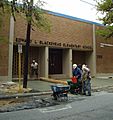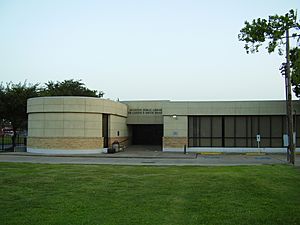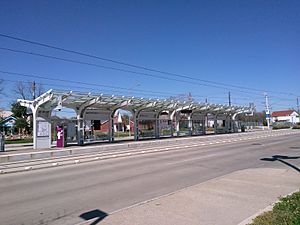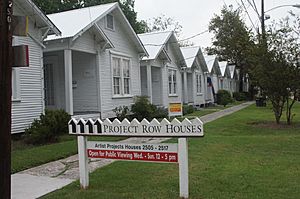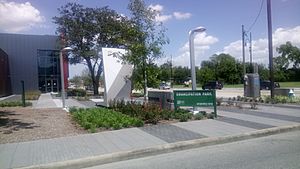Third Ward, Houston facts for kids
Third Ward is a special area in Houston, Texas, United States. It grew from one of Houston's original six main areas, called "wards." You can find it in the southeast part of Houston.
Third Ward is located inside the 610 Loop, which is a big highway loop around Houston. It's just southeast of Downtown Houston and east of the Texas Medical Center. This area became a very important center for Houston's African-American community. People often call Third Ward "The Tre."
A professor named Robert D. Bullard, who teaches at Texas Southern University, once said that Third Ward is "the city's most diverse black neighborhood." This means it has many different kinds of people from the larger Black community in Houston.
Contents
History
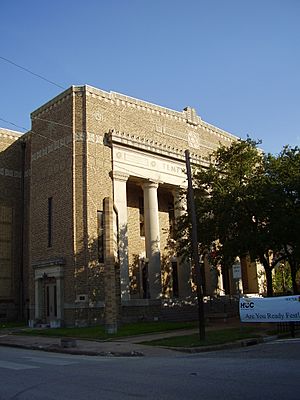
After Houston was founded in 1836, the city leaders divided it into four main areas called wards. The original Third Ward was a much larger area. It stretched south from Congress Street and east of Main Street, going all the way to the Brays Bayou. This old area included parts of what are now Downtown Houston and Midtown Houston, as well as the Black residential area we know as Third Ward today.
In the 1800s, the eastern part of Downtown Houston, which was then part of Third Ward, was a very fancy neighborhood with beautiful Victorian-style homes. But around 1910, when Union Station (a train station) was built, the area started to change. Hotels opened for travelers, and over time, the neighborhood became less fancy. Even though the city stopped using the "ward" system in the early 1900s, people still called this area "Third Ward."
Historically, white people lived in the southern part of Third Ward, while African Americans lived north of Truxillo Street because of economic separation. By the 1930s, the number of white and Black residents in Third Ward was about equal. After World War II, many white residents and a Jewish temple moved out to new suburbs. Third Ward then became mostly African-American. Many Black families moved to Third Ward after the war, especially from Louisiana and other Southern states. Because many of these new residents found it hard to get good jobs, the community often faced poverty.
During the time of racial segregation, Almeda Road in Third Ward was a busy street with many shops, leading to Downtown Houston. But in the 1950s, when Interstate 45 was built, it cut off parts of the historic Third Ward from the rest of the area and brought them into Downtown.
In the 1960s and 1970s, many families in Third Ward moved to suburbs where people of different races lived together. This meant Third Ward lost some of its population and faced less attention and economic activity for many years. Even so, the Almeda Road shopping area stayed busy for a while. However, when Texas State Highway 288 was built, it offered a faster way to get downtown, causing businesses on Almeda Road to decline. Highway 288 also divided parts of Third Ward. Many children of business owners in the area went to college and didn't want to take over their parents' businesses, which also hurt the local economy. The oil bust of the 1980s further harmed Third Ward's economy.
From 1980 to 1990, many African Americans moved from traditional Black neighborhoods like Third Ward to areas in Southwest Houston.
In 1987, a local community group decided to stop calling the area "Third Ward" because they felt the term was old-fashioned and made the area seem isolated. However, many people, including historians, still use the name because it's an important part of the city's history.
In 1998, a report said that Third Ward had about 55,000 residents. It also found that people living and shopping in the area spent a lot of money outside of Third Ward, in places like The Galleria and Meyerland. By 2000, younger business owners started to bring more activity back to the Almeda Road area. Money from property taxes was used to help local businesses and attract new ones. Between 1990 and 2000, the number of Hispanic residents in Third Ward grew, while the Black population slightly decreased.
Around 1996, many artists began moving into Third Ward. By 2000, some people noticed the first signs of "gentrification." This is when wealthier people move into an area, causing property values to rise and sometimes making it harder for original residents to afford to live there. Some activists in Third Ward encouraged residents not to sell their homes to new buyers to prevent this. By 2006, new townhouses were appearing, attracting people without children or older couples. Local leaders like Garnet Coleman worked to keep original residents in the neighborhood by buying land and setting rules to ensure it could be used for affordable housing.
In 2010, a writer noted that Third Ward had not changed as much as other inner-city areas. However, by 2016, the western part of Third Ward was seeing new buildings, influenced by the nearby Midtown area. In a ten-year period ending in 2016, more old buildings were torn down in Third Ward than the county average.
By 2017, gentrification was much more noticeable. More non-Black people moved into the Greater Third Ward because it was close to popular places in Houston. The white population doubled from 2007 to 2017, while the Black population decreased by 10%. By 2020, the Black population in Third Ward had dropped to 45% from 71% in 2010, and the white population jumped by 170%. Home prices and rent also increased a lot.
Layout
Third Ward is located just north of North MacGregor Boulevard and South MacGregor Boulevard. It's northeast of the Texas Medical Center, Hermann Park, and the Houston Museum District, which are west of Texas State Highway 288. It is also very close to Downtown Houston.
Boundaries
It can be tricky to say exactly where Third Ward begins and ends because different people have different ideas. The Third Ward Redevelopment Council uses the Houston Belt & Terminal Railroad as the eastern border. Some local musicians say the cultural southern border is Truxillo Street, because of the different types of houses found north and south of it.
The current ideas of Third Ward's boundaries are different from the original political district. The original district had Congress Street, Main Street, and the city limits to the east and south as its borders. Today, Third Ward is more of a cultural area, and its boundaries have changed over time.
One writer described Third Ward as being southwest of Interstate 45, southeast of Interstate 69/U.S. Route 59/Texas State Highway 288, north of Blodgett and Wheeler, and west of Texas State Highway 5/Calhoun. For an article about restaurants, the western border was adjusted to Almeda Road and the southern border to MacGregor Way.
In the past, when segregation was legal, Alabama Street was the dividing line between Black and white areas.
Composition
Third Ward is a very diverse community. The area west of Texas Southern University, which is considered the heart of Third Ward, has many strong, well-kept brick houses. These homes belong to middle-class and working-class families who own or rent their homes. The brick houses, located south of Truxillo Street, are larger and nicer than the homes north of Truxillo. Over time, African Americans moved into these brick houses. Today, some of these houses are beautifully renovated, some are well-maintained, and some are not as well cared for.
The northern part of Third Ward has many "shotgun shacks," which are small, old wooden houses, and worn-out apartments. Many of these are owned by landlords who don't live in the area. This section has faced challenges like crime and unemployment. In the summer, residents often sit on their porches or visit friends on the street to cool down. Third Ward also has many churches, some of which still attract members who live in suburbs like Missouri City. The shotgun shacks, north of Truxillo Street, are smaller and cheaper homes that have historically been lived in by working-class African Americans. Some are still lived in, while others are empty and boarded up.
Emancipation Avenue, which used to be called Dowling Street, is a main road running through Third Ward. It was renamed in 2017. This street is known as the center of Houston's blues music culture. It used to be the main shopping area of Third Ward and still has many active businesses, though some blocks have empty lots and old buildings.
As of 2004, Third Ward had the most "you buy, we fry" fish restaurants in Houston.
Today, Third Ward is a mix of old and new as it slowly changes. You can see beautiful brick homes next to small, local restaurants, and old meat markets that have become vegan coffee shops. Non-profit arts groups like Project Row Houses are right next to still-occupied row houses.
Hermann Park, the Museum District, and the Texas Medical Center are considered part of Third Ward by the Redevelopment Council, even though they might not be the first places people think of when they hear "Third Ward."
Demographics
Third Ward is mainly an African-American community. As of 2011, over 13,000 people live there. By 2019, the area had changed quickly, with more people, more diversity, and higher living costs.
In 2015, the Greater Third Ward Super Neighborhood, as defined by the City of Houston, had 14,295 residents. About 67% were non-Hispanic Black, 14% were Hispanic, 13% were non-Hispanic white, and 5% were non-Hispanic Asian. In 2000, there were 15,463 residents, with 79% non-Hispanic Black.
In 1870, 29% of all African Americans in Houston lived in Third Ward. By 1910, this number grew to 32%, making it the area where most Black residents lived.
Education
Colleges and universities
The historic Third Ward area is home to Texas Southern University (TSU). This university is a very important cultural and community center for the Third Ward.
The University of Houston is also very close to Third Ward, sharing three main streets. The Redevelopment Council considers the University of Houston to be part of Third Ward.
The area also used to have the Houston Negro College of Nursing, which is now a charter school.
Primary and secondary schools
Public schools
Students in Third Ward go to schools in the Houston Independent School District (HISD).
Elementary schools in Third Ward include Blackshear, which is located right in the area, and Lockhart in Riverside Terrace. All students in the area are zoned to Cullen Middle School and Yates High School.
The Baylor College of Medicine Academy at Ryan, a special magnet school, is in the old Ryan Middle School building. Starting in 2018, students from Blackshear, Lockhart, and MacGregor elementary schools can also choose to attend this school. The new Energy Institute High School campus opened in Third Ward in 2018.
The Texas Southern University/Houston Independent School District Charter Laboratory School is located in Cuney Homes. The building for Young Women's College Preparatory Academy is also in the Third Ward area, as is DeBakey High School.
The William A. Lawson Institute for Peace and Prosperity has a campus on Scott Street called “The Lawson Academy,” serving students from 6th to 8th grade.
History of public schools
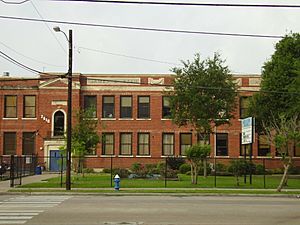
The building that is now Ryan Middle School, and used to be Yates High School, was a very important school for Third Ward. Many teachers, ministers, and lawyers from the community went to school there.
Blackshear Elementary School opened in 1916. In the 1950s, after a new Allen Elementary opened elsewhere, the old Allen campus became the Yates Annex for Black 7th graders. In 1956, it was renamed J. Will Jones Elementary School.
Due to fewer students, HISD closed Douglass Elementary School in May 2005. After Hurricane Katrina in the fall of 2005, Douglass temporarily reopened to help students who had moved to Houston because of the hurricane. In 2006, HISD sold the Douglass building to Yellowstone Academy.
In May 2006, Kazi Shule, another HISD-affiliated charter school, closed. The TSU/HISD Lab School opened in fall 2006. Before the 2009-2010 school year, J. Will Jones Elementary School, which served parts of Third Ward, was combined with Blackshear.
In March 2013, the HISD board voted to close Ryan Middle School and send its students to Cullen Middle School. In 2014, Dodson Elementary also closed, and its Montessori program moved to Blackshear Elementary.
Charter schools
The Lawson Academy, formerly WALIPP-TSU Preparatory Academy, is a charter middle school in the Third Ward area.
KIPP Houston Public Schools runs the KIPP Liberation College Preparatory School, a middle school charter school, in Third Ward. KIPP also has KIPP Sunnyside High School nearby, which some Third Ward students attend. KIPP PEACE Elementary School, another KIPP school near Third Ward, opened in 2011.
Pro-Vision Academy started as an HISD-affiliated charter school for boys in 1995 in Third Ward. After 2008, it moved to a new campus in Sunnyside.
Private schools
The Roman Catholic Archdiocese of Houston operates Catholic private schools in the area. St. Mary of the Purification School (kindergarten through fifth grade) and St. Peter the Apostle School were in the area. St. Mary opened in 1930 and closed in 1967, but reopened in 1980 as a Montessori school. St. Peter the Apostle, which served PreK-8 students, closed in May 2019 due to fewer students.
Yellowstone Academy, a Christian private school, is in Third Ward. It opened in August 2002 and later bought the former Douglass Elementary School building in 2006.
The Wheeler Avenue Christian Academy is a private school for students from kindergarten to fifth grade. It is part of the Wheeler Avenue Baptist Church on Scott Street.
Gallery of schools
-
Texas Southern University/Houston Independent School District Charter Laboratory School in Cuney Homes
Public libraries
The Third Ward is served by the Houston Public Library Smith Neighborhood Library, located at 3624 Scott Street.
Transportation
The Metropolitan Transit Authority of Harris County (METRO) provides public transportation, including buses and the METRORail tram service. Several METRORail Purple Line stations serve Third Ward:
- Leeland/Third Ward station (in East Downtown)
- Elgin/Third Ward station
- TSU/UH Athletics District station
- UH South/University Oaks station
Arts and culture
The Trinity United Methodist Church, started in 1848, is the oldest African-American church group in Houston. It's not in the oldest church building, but its congregation is the oldest.
Project Row Houses (PRH) is a non-profit organization in northern Third Ward that focuses on arts and culture. It was founded in 1993 by artist Rick Lowe and others. They wanted to bring positive change to this historic Black neighborhood. PRH is a special project that combines art, saving old buildings, providing affordable housing, building community, and helping people grow.
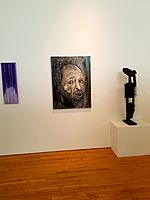
Third Ward has many different kinds of restaurants. For example, the original Frenchy's Chicken and another one of its locations are both in Third Ward.
The University Museum at Texas Southern University (TSU) is one of the few museums in Texas that highlights art and items made by artists from the African Diaspora (people of African descent around the world).
The Community Artists' Collective is a non-profit group that has supported the Third Ward community for thirty years. It provides educational programs and help for African-American artists.
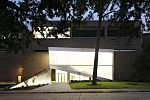
A writer for the Houston Chronicle said in 2020 that "The 'Tre, as we natives say, is a predominately Black neighborhood just south of downtown and east of the Museum District. Despite the stereotypes that often come with inner-city Black neighborhoods, Third Ward is also home to some of the city's most noted and greatest African-American artists, activists, educators and leaders."
The Blaffer Art Museum at the University of Houston shows major exhibitions of national and international contemporary artists, as well as artwork by students from the University of Houston School of Art.
Parks and recreation
Emancipation Park and its Community Center are located at 3018 Dowling Street. Around 1870, the original owners bought this park to celebrate the end of slavery in the United States. The community center has an indoor gym, a weight room, and meeting rooms. The park offers an outdoor basketball court, lighted sports fields, lighted tennis courts, a swimming pool, a playground, and picnic areas.
Moses Leroy Park is at 3100 Trulley Street. Our Park is at 2604 Alabama Street. Zurrie M. Malone Park is at 2901 Nettleton Street. Riverside Park is at 2600 Calumet.
The Third Ward is part of the service area for the Sam Houston Area Council Boy Scouts.
The Houston Texans YMCA, which serves Third Ward, is in Palm Center. The previous YMCA in Third Ward was the South Central YMCA, located between the two universities. During the time of de jure racial segregation, this YMCA was open to African Americans. It was an important place for activists during the Civil Rights Movement and hosted NAACP meetings. The old building closed in 2004 due to problems and low membership.
Notable residents
- Debbie Allen (Actress/Dancer/Director)
- Phylicia Allen (Actress/Dean of Howard University Chadwick Bozeman School of Fine Arts)
- Michelle Barnes, artist and arts administrator
- Beyoncé
- Arnett Cobb
- Albert Collins
- Johnny Copeland
- Garnet Coleman (State representative)
- J. Elle, writer
- George Floyd
- Sam "Lightnin'" Hopkins
- Solange Knowles
- Anthony Obi "Fat Tony"
- Pat Parker
- Rinny Perkins, writer and artist
In popular culture
Rapper Drake has mentioned Third Ward, and Houston in general, in his music. In his 2014 song "Days in the East," he says: "Know I do this [stuff] for Third Ward already/ Know I do this [stuff] for H-town already." Even though Drake is from Toronto, he often talks about Houston in his songs and feels a connection to the city.
Houston rappers often mention Third Ward in their song lyrics.


